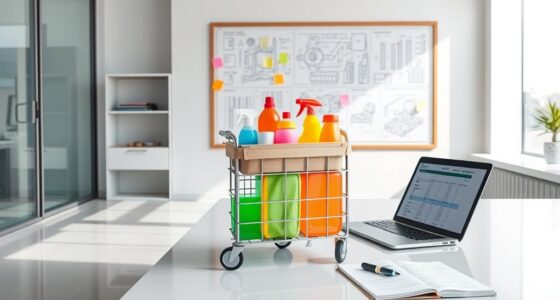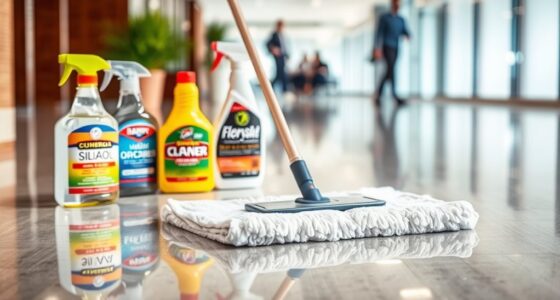To clean a retail space efficiently, focus on high-traffic areas like entrances and checkouts. Use brooms, mops, and vacuum cleaners daily to remove debris and maintain hygiene. Implement eco-friendly products for safety and sustainability. Regularly inspect and establish SOPs for consistency. Disinfect high-touch surfaces after each use, and embrace a routine for ongoing cleanliness. By optimizing your strategies and tools, you can create a welcoming atmosphere that boosts customer satisfaction and employee wellness. Discover more effective cleaning techniques.
Key Takeaways
- Establish a cleaning schedule that prioritizes high-traffic areas, ensuring consistent hygiene and customer satisfaction.
- Utilize eco-friendly cleaning products and reusable tools to promote a healthier environment and reduce waste.
- Implement Standard Operating Procedures (SOPs) for cleaning tasks to ensure consistency and accountability among staff.
- Regularly inspect and train employees on effective cleaning techniques to maintain high cleanliness standards.
- Adopt a D.I.R.T. routine for floor care, ensuring regular vacuuming and mopping to create a welcoming atmosphere.
Understanding Retail Cleaning Needs and Spaces
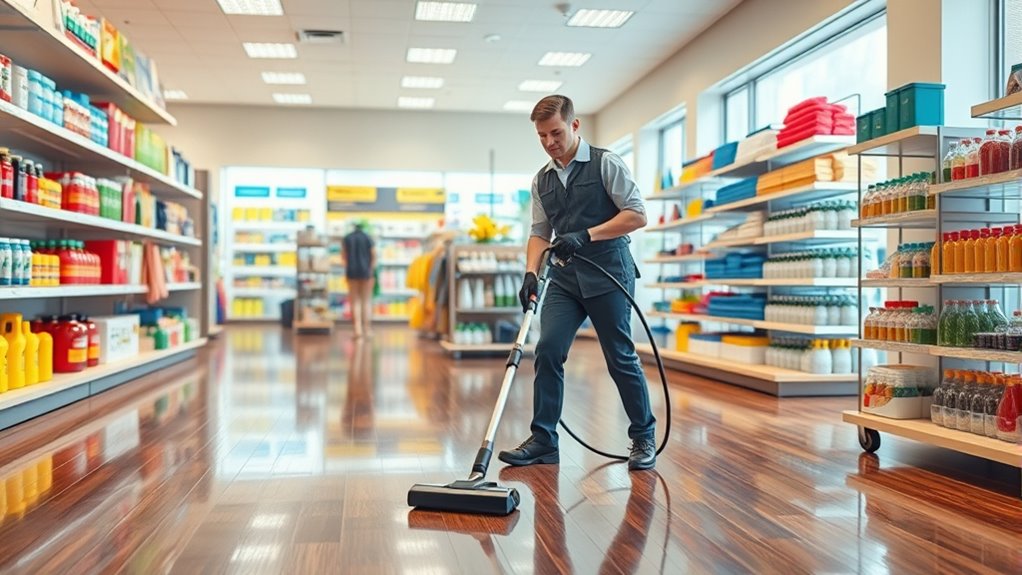
When you think about retail cleaning, it’s clear that each type of store has its own unique needs. Grocery stores, for instance, require frequent cleaning of high-traffic areas, especially spill clean-ups in produce sections.
In contrast, clothing stores focus on regular dusting and polishing of displays. To create a clean and inviting environment, tailored cleaning services become essential, ensuring you address specific challenges unique to your retail space.
Establishing Standard Operating Procedures (SOPs) for cleaning tasks helps maintain consistency and accountability. Regular inspections and employee training on effective cleaning techniques are crucial to uphold high cleanliness standards. Incorporating mindful decluttering strategies can also streamline cleaning efforts and enhance the overall shopping experience.
Ultimately, this commitment enhances the customer experience and fosters brand reliability, encouraging shoppers to return time and again.
Tools and Techniques for Effective Retail Cleaning
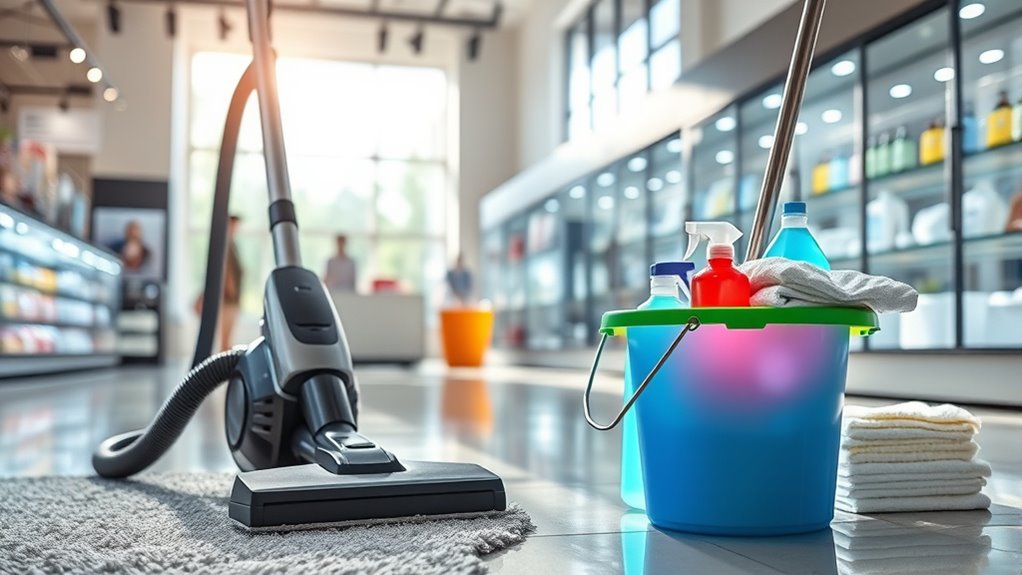
Creating a clean and inviting retail space relies heavily on the right tools and techniques. To maintain a clean and hygienic environment, consider the following essentials:
- Brooms and Mops: For daily sweeping and mopping in high-traffic areas.
- Vacuum Cleaners: Ideal for carpets and hard-to-reach spots to prevent the buildup of dirt.
- Microfiber Cloths: Effective for dusting and wiping down surfaces with appropriate cleaning solutions.
- Eco-Friendly Cleaning Products: Promote health and safety while aligning with sustainable practices.
Implementing regular maintenance and proper cleaning techniques guarantees effective cleaning.
Establish a cleaning schedule to address high-traffic areas consistently, allowing surfaces to dry adequately to avoid damage.
This approach not only keeps your space clean but also enhances the shopping experience for customers.
Maintaining High-Traffic Areas and Floor Care

To maintain a clean and inviting retail space, it’s crucial to prioritize high-traffic areas like entrances and checkout counters. Regular cleaning helps prevent dirt and grime buildup, creating a safe environment for both customers and staff.
Incorporate daily cleaning routines, such as sweeping or vacuuming to remove loose debris, followed by mopping with effective cleaning solutions to guarantee hygiene. Restrooms require multiple cleanings each day, focusing on toilets, sinks, and floors to uphold high cleanliness standards and enhance customer satisfaction.
Additionally, adopt a D.I.R.T. routine for floor care—Daily care, Interim solutions, Restorative care, and Treatment of spots. Promptly address any damage to flooring, preventing deterioration and maintaining a welcoming retail atmosphere as part of your overall cleaning program.
Area-Specific Cleaning Strategies
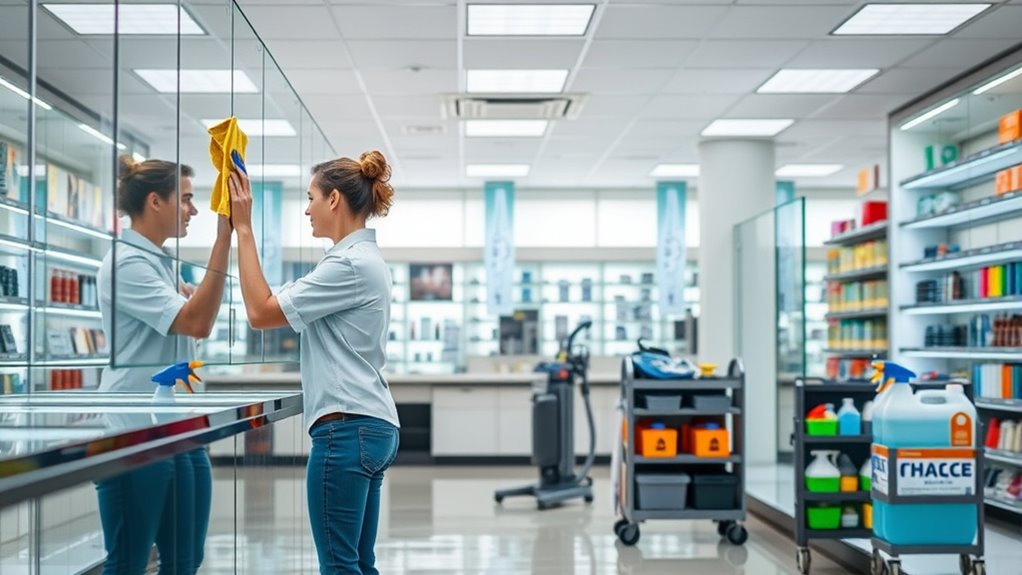
While every area in a retail space requires attention, adopting area-specific cleaning strategies guarantees that the most critical zones receive the focus they need.
Prioritize these areas to enhance cleanliness and customer satisfaction:
- Entryways: Implement preventive matting to reduce dirt and debris by up to 85%.
- Restrooms and Changing Rooms: Clean at least twice daily, increasing frequency during peak hours for ideal hygiene.
- High-Touch Areas: Disinfect shopping cart handles after each use and provide disinfecting wipes for customers.
- Floors: Regularly vacuum and follow a D.I.R.T. routine to maintain a safe retail environment.
These targeted cleaning practices not only boost employee health but also enhance customer confidence in your store’s hygiene.
Green Cleaning Practices and Sustainability in Retail

As consumers become more environmentally conscious, embracing green cleaning practices in retail not only meets their expectations but also enhances your store’s appeal.
By using environmentally friendly cleaning products, you promote a healthier environment and improve indoor air quality for everyone.
Implementing reusable cleaning tools helps in minimizing waste, supporting sustainable retail operations.
Additionally, consider low-flow cleaning equipment to conserve water, which aligns with your sustainability goals while lowering operational costs.
Regular maintenance programs focused on energy efficiency can extend the lifespan of your building materials, leading to further cost savings.
Ultimately, adopting green cleaning practices showcases your commitment to sustainability, fostering a positive public image that resonates with eco-minded shoppers.
Employee Wellness and Safety in Cleaning

When you’re cleaning a retail space, using eco-friendly products is essential for your health and the environment. Ergonomic cleaning equipment can also help you avoid injuries, making your tasks easier and safer. Additionally, prioritizing employee wellness is crucial in maintaining a productive and safe work environment. Furthermore, engaging in continuous learning about effective cleaning techniques can enhance both efficiency and safety in the workplace.
Eco-friendly Cleaning Products
Choosing eco-friendly cleaning products is essential for maintaining employee wellness and safety in retail spaces. By opting for environmentally friendly solutions, you can create a clean and safe environment for both employees and customers.
Here are four benefits of using eco-friendly cleaning products:
- Reduce exposure: Minimize harmful chemicals that can lead to work-related illnesses.
- Biodegradable and non-toxic: Guarantee a healthier workspace, promoting well-being for everyone.
- Boost employee morale: A safer, pleasant atmosphere enhances productivity and job satisfaction.
- Improve brand image: Align with sustainability goals, attracting environmentally conscious customers.
Investing in eco-friendly cleaning products not only supports a healthy and safe workplace but also reinforces your commitment to the environment through responsible cleaning services.
Ergonomic Cleaning Equipment
Implementing ergonomic cleaning equipment can greatly enhance employee wellness and safety in retail environments. Tools like lightweight vacuum cleaners and adjustable mops are designed to improve cleaning efficiency while prioritizing employee comfort.
By reducing physical strain, these ergonomic solutions allow you to tackle cleaning tasks more effectively, leading to a productivity improvement of 25-30%. Incorporating ergonomic practices into your cleaning routines not only minimizes the risk of injury but also boosts employee satisfaction and retention, as workers feel valued.
Additionally, the rise of robotic cleaning equipment helps streamline operations, enabling staff to focus on more complex tasks while ensuring your retail space remains clean and well-maintained. Embracing these innovations is essential for a healthier, more productive workplace.
The Future of Retail Cleaning Services
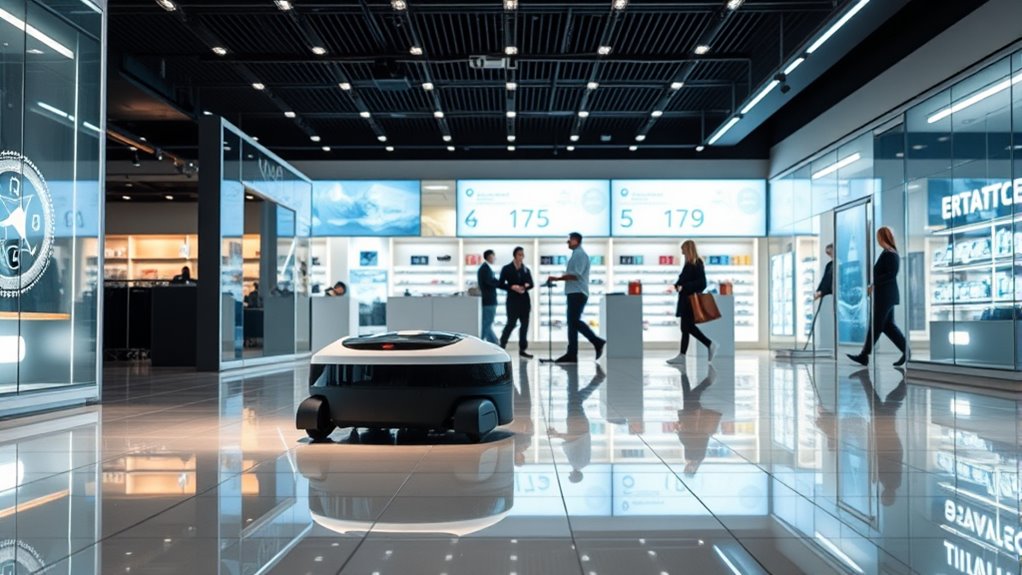
As retail spaces evolve, the future of cleaning services is set to transform dramatically, driven by advancements in technology and growing sustainability demands.
To meet these challenges, you should consider the following trends:
- Automation and Robotics: Expect over 150,000 autonomous mobile robots in retail environments by 2025, enhancing cleaning efficiency and reducing labor costs.
- Eco-Friendly Cleaning: Adopt biodegradable products and reusable cleaning tools to prioritize sustainability and protect the environment.
- Tailored Cleaning Solutions: Focus on customer satisfaction through customized cleaning and disinfecting practices that address specific retail environments.
- Regular Maintenance Programs: Implement these to extend the lifespan of cleaning equipment, improve air quality, and contribute to overall workplace hygiene, ensuring a healthier environment for customers and employees alike. Additionally, maintaining cleanliness reduces allergens and pollutants, which is essential for enhancing indoor air quality.
Frequently Asked Questions
What Is the 20 Minute Rule in Cleaning?
The 20 Minute Rule in cleaning suggests you tackle tasks in short, focused bursts of 20 minutes. You set a timer, concentrate on specific areas, and avoid feeling overwhelmed.
This method helps you maintain energy while ensuring high-traffic and high-touch surfaces get the attention they need. By breaking cleaning into manageable chunks, you’ll not only keep your space tidy but also feel more engaged and accountable for the cleanliness around you.
What Are the 5 Basic Cleaning Principles?
When it comes to cleaning, you can’t just paint a pretty picture; you need solid principles.
First, establish consistency in your cleaning routine.
Second, focus on visibility—make your efforts noticeable.
Third, prioritize high-touch areas to prevent germs.
Fourth, arm yourself with proper tools and techniques to do the job right.
Finally, commit to regular training for everyone involved, ensuring everyone’s on the same page about cleanliness and hygiene.
How Do You Clean a Retail Store?
To clean a retail store, start by creating a daily checklist that includes sweeping, mopping, and disinfecting high-touch areas like carts and checkout counters.
Train your staff on effective cleaning techniques and assign specific tasks to guarantee accountability.
Use eco-friendly products to keep the environment safe for everyone.
Don’t forget to conduct regular inspections to identify any areas that need extra attention, maintaining a welcoming atmosphere for your customers.
What Is the 7 Step Cleaning Process?
The 7 Step Cleaning Process is like a superhero for maintaining cleanliness!
First, you prepare by gathering your tools and products.
Next, you tackle specific areas, ensuring you’re thorough.
After that, you inspect your work to catch any missed spots.
Each step promotes accountability among your team, fostering a culture of cleanliness.
Regular training keeps everyone sharp and consistent, making it easier to impress customers with your store’s sparkling appearance.
Conclusion
To sum up, a clean retail space isn’t just a nice-to-have; it’s the welcoming smile that invites customers in. By using the right tools and techniques, you can transform your space into a pristine environment that boosts sales and enhances customer experience. Remember, maintaining cleanliness is like tending a garden—consistent care leads to vibrant growth. So, embrace these strategies, and watch your retail space flourish, attracting customers like bees to a blooming flower.



